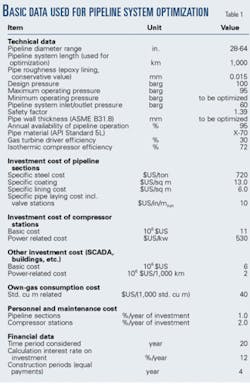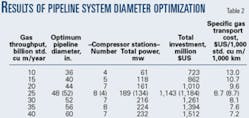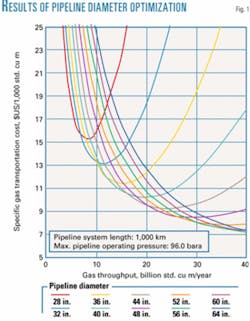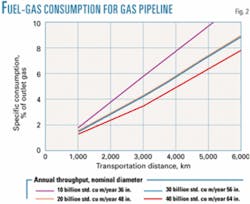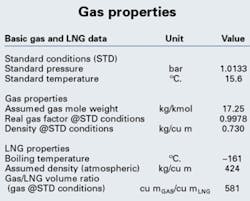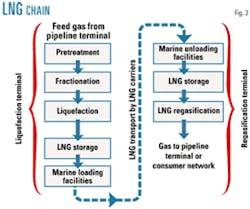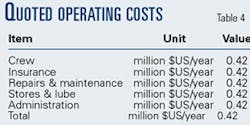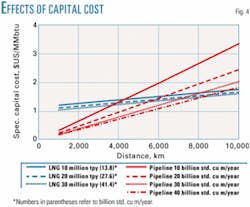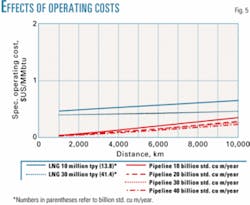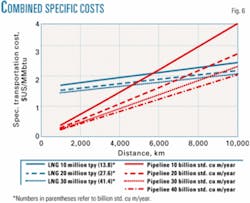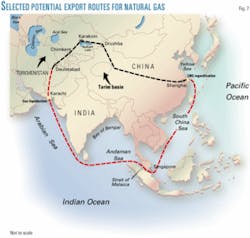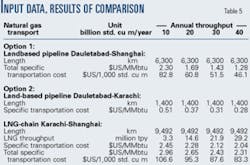An economic analysis comparing two options for moving natural gas—pipeline only and combined pipeline and LNG scheme—from Turkmenistan to China has shown the clear superiority of the long-distance pipeline option.
For delivery of 30 billion cu m/year of natural gas to China, the analysis showed, the land-pipeline option cost was $1.43/MMbtu, while the combined pipeline-LNG cost was $2.43/MMbtu.
This article compares the specific gas transportation cost for both pipelines and LNG chain, taking account of capital and operating costs.
The results are then applied to an example of transporting natural gas from Turkmenistan to China via pipeline and comparing this to an alternative hybrid scheme involving a shorter pipeline with LNG chain.
The comparisons contained in this article are based solely on techno-economic data that assume both modes considered are loaded to design capacity from start-up and that do not consider taxes, transit fees, or other charges. No account has been made for geopolitical and strategic considerations.
The comparison basis is a dry natural gas with a methane concentration of 95% with an assumed consumption cost of $40/1,000 cu m.
Accompanying boxes summarize natural gas and LNG properties and provide conversion factors.
Land-based pipeline; LNG chain
Long-distance natural gas pipeline transportation systems have multiple compressor stations to maintain movement of the gas. The compressors are usually driven by turbines fueled by a small amount from the pipeline gas.
The optimum pipeline diameter and compressor station spacing are determined by a combination of technical and economical parameters summarized in Table 1.
Calculations are based on a single, polyethylene coated, epoxy-lined pipe, with a system length of 1,000 km and maximum operating pressure of 95 barg (about 1,377 psig).
The results of the pipeline diameter optimization are shown in Fig. 1 and Table 2 for an assumed pipeline system length of 1,000 km.
For different pipeline lengths, optimum pipeline diameters remain about the same, and the number and total power of compressor stations and the specific transportation cost increase linearly with increased transportation distance.
Fig. 2 shows the specific fuel-gas consumption of the compressor stations as a function of annual throughput and of the pipeline length. Fig. 3 shows the LNG chain layout.
The cost of producing, transporting, and regasifying LNG is continually falling and is now estimated to be in the range of $2.80 to$3.40/MMbtu.12 Table 3 provides an overview of LNG chain costs.
There are five steps in the LNG process: pretreatment, drying, separation, liquefaction, and storage.
Cost bases
The cost of a new LNG plant is estimated as a factor of the annual capacity of the overall liquefaction facility. Capital expenditures (capex) are in the range of $200-400/tonne/year (tpy). For a new project using clean gas from a pipeline terminal, a total installed cost (TIC) of $250/tpy has been used.2-5 This number is based on a 5 million-tpy LNG terminal; for larger throughputs, a cost reduction exponent of 0.85 applies.
Calculation of the cost of the fuel gas required for liquefaction considers a specific fuel-gas requirement of 7% of the inlet gas and specific own-gas consumption cost of $80/1,000 cu m (Mcm).
(Note: The specific fuel-gas requirement of 7% for liquefaction has been selected at the lower limit of the usual 8-9% range,10 in order to account for potential process optimization and to enable a fair and neutral cost comparison between LNG and pipeline transport.)
The gas price of $80/Mcm assumes that this gas could be made available to the market as LNG, were it not required for liquefaction.
Assumed costs for operation and maintenance correspond to the plant investment cost of 2%/year.
This is a usual value applicable for stations operating under relatively clean medium conditions (e.g., pump or compressor stations) and was also considered appropriate for liquefaction terminals.
The estimation of the annuity of investment assumed a time period of 20 years at an interest rate of 12%. Assumed construction period of the liquefaction facilities was 5 years, with five equal payments during construction time.
The annuity method for comparison of investment alternatives normally uses 20 years, despite the well-known fact that the effective lifetime of land-based installations (such as pipelines and terminals) or ships is normally considerably higher.
The 12% interest rate selected is an imputed value that also contains risk and earnings and depends finally on the individual situation of a potential investor.
Even if the time period considered and the interest rate selected may have a considerable influence on the absolute value of transportation cost, this influence moderates if several alternatives are compared to each other.
An assumed construction time of 5 years for a liquefaction terminal considers not only the construction and installation time of the equipment but also the time for preparation of the maritime terminal environment. Selection of five equal payments during construction time was a reasonable assumption for a general comparison of alternatives.
Regasification
At the receiving point, the LNG is unloaded at a specialized terminal which typically includes a jetty and unloading facilities, LNG storage equal to at least a single tanker cargo, regasification facilities, and a gas connection line to a pipeline terminal or a consumer network.
Regasification-plant investment cost is considerably lower than for liquefaction-plant investment cost, amounting to about one third of the liquefaction investment cost.
For the purpose of this cost estimation and comparison, the assumed specific regasification investment cost corresponds to $100/tpy capacity of LNG, based on 5 million-tpy LNG terminal. For larger throughputs, a cost reduction exponent of 0.85 is used.
The calculated cost of the fuel gas required for regasification assumes a specific fuel-gas consumption of 2.5% of the LNG to be evaporated, which represents the average value in the range reported (2-3%).2
Assumed costs for operation and maintenance correspond to 2%/year of the plant investment, per the earlier discussion of investment costs.
Data were assumed to be similar as for liquefaction but with shorter construction time of 3 years.
Shipping
Current use employs spherical independent and membrane tank types because of their economy and reliability. Following are the typical characteristics of these LNG vessels:37
- Ship size, 135,000 cu m. The current LNG fleet consists of 107 LNG ships ranging in capacity from 120,000 cu m to 144,999 cu m and representing 78% of the total volume of LNG shipping capacity.
A ship size of 135,000 cu m is typical, despite one vessel of 145,000 cu m and others up to 138,000 cu m, which corresponds practically to the typical value selected.3
Even if future vessels become moderately larger, vessel size exercises only a slight influence on the cost of the entire LNG chain.
- Cargo utilization (ship-loading capacity), 98%.
- Cargo heel: 5% of the cargo loaded assumed to be returned as "cargo heel" on the ballast leg to keep the cargo cool.
- The boil-off gas (BOG) utilized as a fuel for the main boiler of the steam turbine, in a dual-fuel diesel engine, in a gas combined cycle (gas + steam turbines), or reliquefied.
- Typically 0.15%/day boil-off rate (BOR) when loaded; 0.10%/day BOR when in ballast.
- Vessel sailing speed: about 19 knots (about 35.2 km/hr) for 135,000 cu m vessels.
- Ship port time: 1 day for loading and 2 days for discharge (plus 1 day for Suez Canal transit, if required).
- Operating days/year: 350 (15 days down time/vessel).
- Bunker consumption: while steaming, 160 tonnes/day of fuel oil; in ports, about 40 tonnes/day of fuel oil plus 3 tonnes/day of marine diesel.
- Proportion of bunker consumption accounted for by boil-off gas differs from ship to ship; assumption is 50%, but no allowance for boil-off is made in the calculation of the total fuel.
- Life span of LNG carriers: about 40 years.
Cost assumptions: investment, operations
Investment cost for a standard 135,000 cu m LNG vessel amounts currently to about $165-170 million.2 3
Table 4 shows the typical operating costs (excluding fuel cost) consisting of crewing, insurance, repairs, and maintenance (such as stores, spares, victualling, lubes, chemicals, and gases, etc.) for a standard 135,000 cu m LNG vessel.3
For fuel and other voyage costs, the following assumptions have been made:
- Fuel oil (bunker) cost averages $150/tonne; diesel price averages $220/tonne.3
- Port charges average $50,000/call but vary widely depending on location.3
- Suez Canal passage (if required by route selected): $223,000.8
Estimating the annuity of investment assumed a period of 20 years at an interest rate of 12%.
Construction period of the vessels was assumed as 2 years, with two equal payments during construction time.
Transportation cost comparison
Figs. 4 and 5 summarize the capital and operating costs of pipeline and LNG chain systems in relation to the distance from gas source to market.
The land-based pipeline system shows an almost linear relationship between specific transportation cost and distance with a strong reduction for increase in capacity.
By contrast, the LNG chain system shows a high cost offset with a moderate relationship between specific cost and distance and with a weak reduction for increase in capacity.
Fig. 6 shows the combined operational and capital effects in relation to distance from gas source to market, whereby the same transportation distance has been applied for both modes of transportation.
While for shorter distances, the pipeline mode is the more economic solution, for longer distances, the LNG chain mode comes into its own.
A comparison of equal transportation distances might, however, be somewhat hypothetical, and it is therefore required to prepare project-related comparisons under consideration of the actual transportation distances of each mode.
The results obtained were applied to an example of transporting natural gas from Turkmenistan to China via pipeline and comparing this to an alternative hybrid scheme involving a shorter pipeline with LNG chain.
This example considers transportation of natural gas from Dauletabad, Turkmenistan, to Shanghai, China, for the following two alternatives (Fig. 7).
- Alternative 1: Land-based pipeline from Dauletabad via Chardzhou, Chimkent, Karakoin (Kazakhstan), Lanzhou, to Shanghai (about 6,300 km) across mountainous regions and Category 3 earthquake zones.
- Alternative 2: LNG chain including a land-based pipeline section from Dauletabad through Afghanistan and Pakistan to the coast of Pakistan (about 1,400 km); liquefaction of the natural gas at the coast; LNG transport by LNG carrier via the Strait of Malacca passing Singapore to Shanghai (about 5,125 nautical miles = 9,492 km).
The input data and results of the comparison of the two transportation alternatives appear in Table 5. The specific transportation cost is related to the delivery point.
The land-based pipeline Alternative 1 is significantly more favorable for natural gas export from Turkmenistan to China compared with the combined transportation system (Alternative 2) via Afghanistan and Pakistan (land-based pipeline, 1,400 km), liquefaction and loading at the coast, sea transport by LNG carrier (9,492 km), and unloading and regasification at the coast in China.
For delivery of 30 billion cu m/year of natural gas to China, the specific transportation cost of Alternative 1 ($1.43/MMbtu) is approximately 59% of the cost for Alternative 2 ($2.43/MMbtu).
References
1. BP statistical review of world energy 2003. www.bp.com.
2. Flower, Andy, and King, Richard, "The Promise and the Pitfalls," LNG Today, 2002, Energy Publishing Network (www.energypublishing.com/lng_today.htm).
3. LNG Tanker Market Report, June 2003, DVB Research & Strategic Planning, www.dvbbank.com.
4. Van Keep, P., "Comparison of Remote Gas Conversion Technologies," Report 594W/029/0/IMTOF (www.synetics.com).
5. Feasibility Study for Oil & Gas Transport from the Caspian Sea Region to Europe, ILF Study Tacis INO 97.01, Tacis Inogate Project, 2002. (www.inogate.org)
6. "The LNG Trades: Adjusting to the Challenge of the Buyer's Market," panel session; GASTECH86 LNG/LPG Conference, Nov. 25-28, 1986, Hamburg.
7. Yuasa, Kazuaki, et al., "Key Technologies of Mitsubishi LNG Carriers–Present and Future," Mitsubishi Heavy Industries Ltd. Technical Review Vol. 38, No. 2 (June 2001); www.mhi.co.jp.
8. Leth Suez Transit Ltd. AS; www.lethsuez.com.
9. "How much does LNG Cost?" University of Houston Law Center, Institute for Energy, Law & Enterprise; www.energy.uh.edu.
10. GIDB Gas Grid Sector; LNG paper, 2001. www.gidb.org.
The authors
Klaus Dieter Kaufmann is a senior process engineering expert with ILF Consulting Engineers, Munich, specializing in complex process calculations, system optimizations for gas, liquid, multiphase, and hot-oil transportation systems as well as for risk assessment and hazardous operations (HAZOP) studies. Kaufmann has 22 years' experience within ILF and holds MSc and PhD degrees in chemical engineering from the Technical University of Munich.
Adolf H. Feizlmayr is partner and managing director of ILF Consulting Engineers. He holds an MSc in petroleum engineering, as well as an honorary doctorate from the Mining University of Leoben, Austria, and has more than 35 years' international experience in the oil and gas industry.


